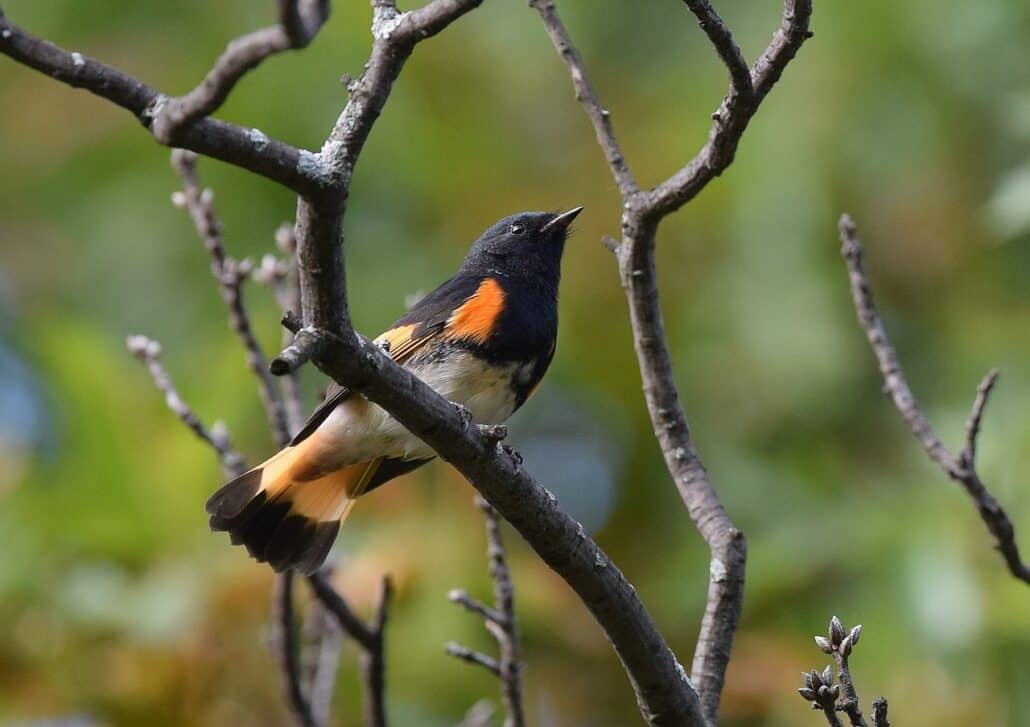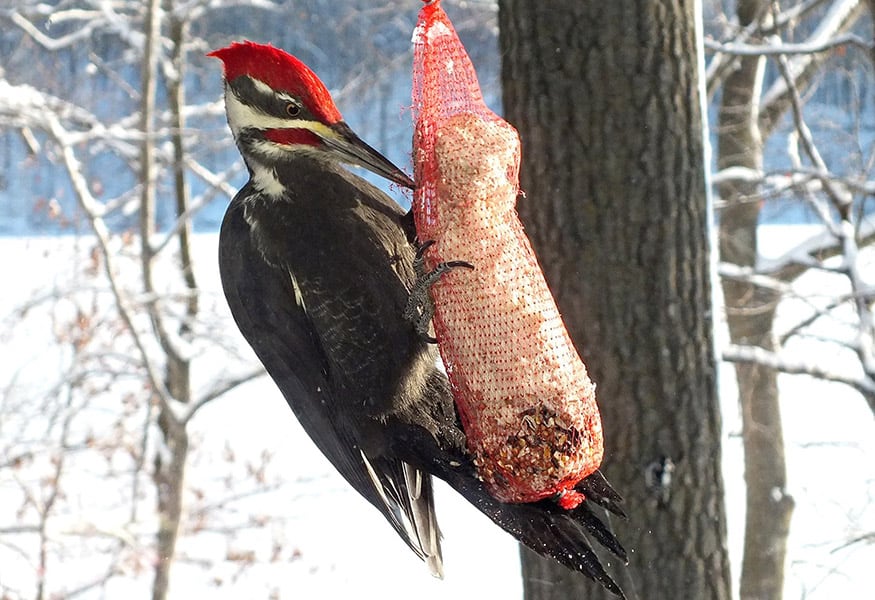Looking at warblers specifically, the western-breeding species tend to winter mostly in Mexico, whereas the eastern-breeding species winter in the Caribbean, Central America, and even South America. Eastern species that have spread west, such as the American redstart, still follow the ancient eastern routes rather than heading to winter in western Mexico, even though it’s much closer.
There are other differences too. Look at the pace of migration—it appears much more laid-back in western warblers, with birds making many more, shorter hops. In the East, the spring warblers race north in strong, concentrated pulses. Sometimes it can seem like the entire population of magnolia warblers goes through your patch of Ontario or Indiana in a couple of days—in fact, that’s not far from the truth.
So western birders have a lot more time to study the birds and enjoy the migration, but it is not so showy. In the East, the migration is showy and spectacular, but there is little time—and you have to be on your game to figure out everything that is going by the binoculars.
This, in effect, is what this article is about: a preparatory guide to warbler identification with a particular focus on features that get short shrift in the books.
Tip #1: Consider Warbler Imposters
What should you be thinking about in terms of warbler identification? Well, one thing that is important to have in the back of your mind is that there are birds that may suggest a warbler but in fact aren’t. Warblers are relatively small songbirds, and most are smaller than a house sparrow.
The yellow-breasted chat, for example, was formerly considered an oddball warbler. It’s almost as large as a towhee, and its bill is thick. All warblers have thin bills—insect-picking tweezers—so anything with a fat seed-cracker-type bill is not a warbler. DNA testing has shown that the chat is more closely related to blackbirds than to warblers!

The family most similar to warblers in overall appearance is the vireos, but these guys tend to look a bit tubby in shape, have a thickset bill, and move slowly. They tend to twist their head a lot, eyeing leaves from all angles in search of food, whereas warblers are a bit more frenetic.
The two North American kinglet species are tinier than warblers, with a generally olive-green coloration, and do a lot of wing flicking and chattering. The female orchard oriole is small enough and yellow enough that it gets confused for a warbler, but its thicker-based bill and rather long and expressive tail set it apart.
Look through your field guide and see what other species in your area are small and greenish or yellowish that you may mistake for a warbler. Keep these in your mental Rolodex in case the bird in the field seems not to fit any warbler in the book—in which case it possibly isn’t a warbler.
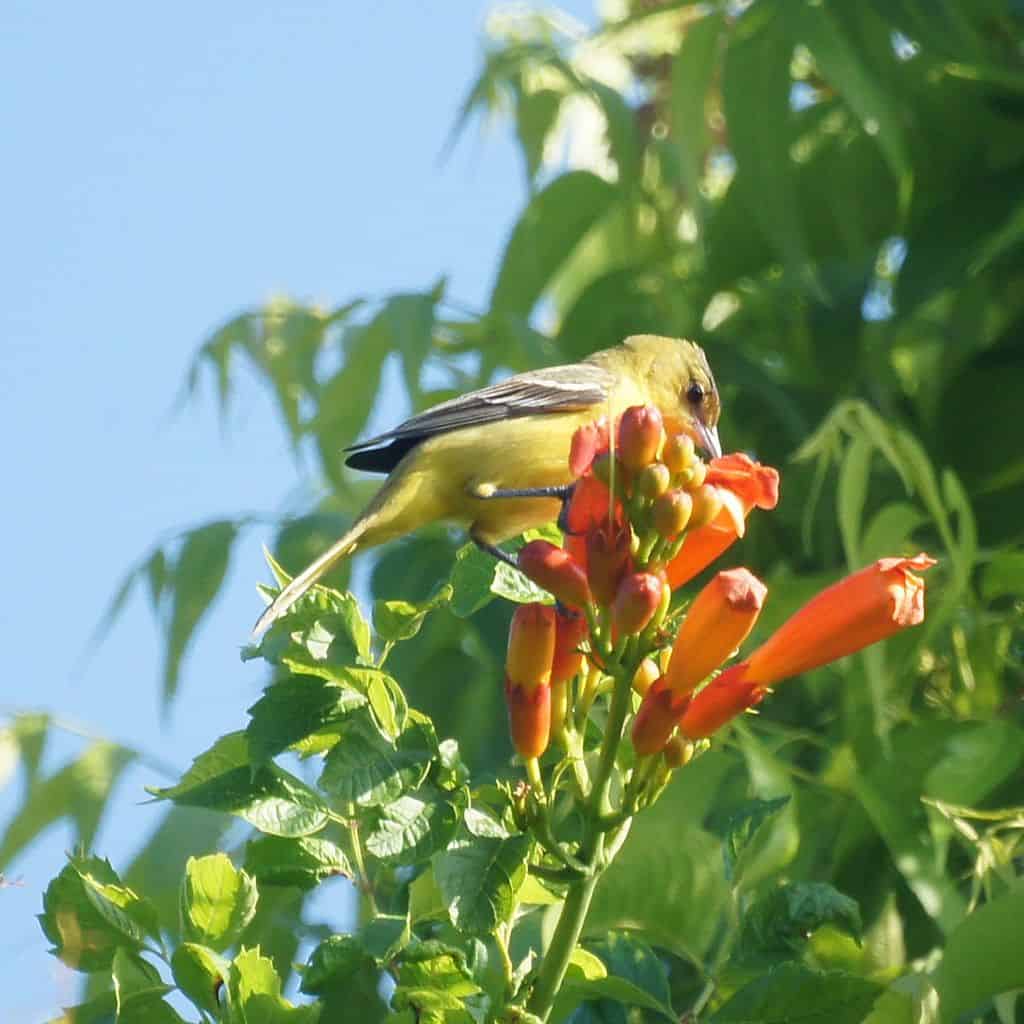
Tip #2: Consider “Shape and Feel”
The next important factor to consider when identifying a warbler is its shape and feel. If this sounds a little too advanced, don’t worry—it’s not as bad as it seems.
When I started birding, the first book I ever picked up was an original Peterson guide. I remember those warbler plates, with each bird lined up nicely, each one looking to the left. All looked about the same in their proportions, but key features differed—wing bars or no wing bars, dark or yellow rumps, yellow caps, rusty cheeks, orange throats, and so on. It was fantastic to have the birds schematically there on the page to compare, and it greatly facilitated identification for me.
But I was missing something that I did not realize until a lot later on. The truth was that these warblers are not all the same in their proportions. I remember a young visiting birder from England—over there, they were keenly into this shape thing—asking me if the pine warbler had any obvious shape differences from other warblers. Frankly, I did not know! I had never paid attention.
Later in the day we saw a pine warbler, and it was clear that the bird was rather tubby and thickset, with a relatively big bill and a looong tail. I had been missing a whole other facet to birding: paying attention to the “look” of the bird, not just the colors.
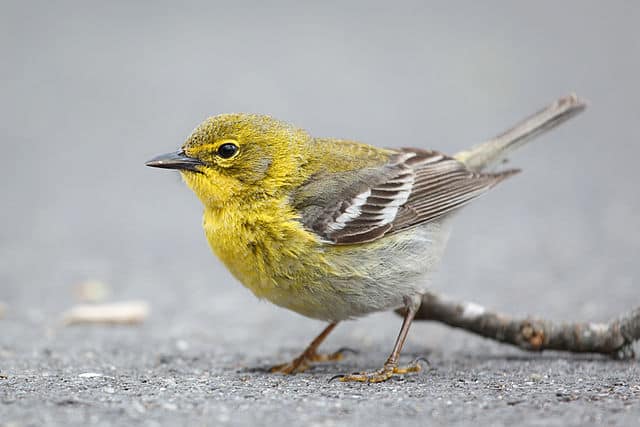
As you’re out in the field enjoying warblers, ask yourself questions about them that will make you focus on the birds’ “looks.” Is this a big warbler or a small warbler? Is its bill fine or a bit thicker? Is it short-tailed (like a parula) or long-tailed (like an American redstart)? Considering shape and size can do wonders for identifying warblers, particularly when they are way up in a tree and backlit.
The more you practice paying attention to shape and size, the better you get at it. It is no harder than remembering which warblers have wing bars and which do not. So next time you get a good look at a gorgeous warbler, enjoy it, but also analyze it a bit.
Tip #3: Consider Behavior and Habitat
What is the bird doing, and where is it doing it? Some warblers are ground dwellers, such as the ovenbird and the two waterthrushes. Others stay near the ground in thick vegetation—MacGillivray’s, mourning, and Connecticut warblers and common yellowthroat. Others like to be at the tip-tops of trees: cerulean, Blackburnian, and blackpoll warblers.
Then there are some whose behavior is entirely oddball, like the black-and-white warbler that climbs up tree trunks like a nuthatch. The yellow-throated warbler sometimes engages in this nuthatch-like behavior, too.

In the late 1950s, biologist Robert MacArthur watched warblers in spruce forests of the North Woods. He found that different species used different sections of trees. Cape May and Blackburnian warblers enjoyed the treetops, so both are canopy specialists, although the Blackburnian sometimes occupies middle heights too.
The yellow-rumped was down near the ground below the open branches, or in the center of the tree. The bay- breasted liked the lower to middle heights, as well as the central area near the trunk. The black-throated green was in the middle to upper heights, but closer in to the trunk than the canopy specialists.
MacArthur’s work still stands as a classic in what is called community ecology, and it sparked more work on warblers. I have to tip my hat to the guy—can you imagine the number of bug bites he must have suffered to get all that data? We owe you, Dr. MacArthur!
Further studies found that the smaller warblers, such as those in the genus Vermivora—Tennessee and Nashville warblers, for example—and the northern parula are light enough to forage on the tips of branches, and they have fine bills for picking little things out of little places.
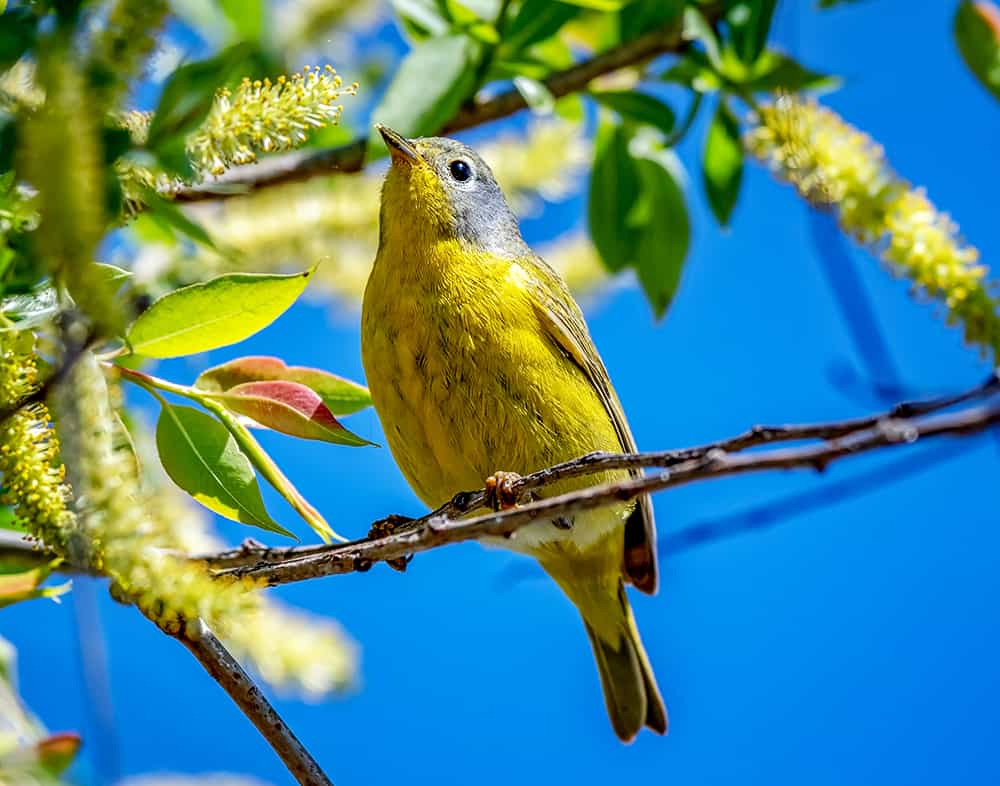
The worm-eating warbler has made a good living concentrating on hanging dead leaf clumps—probing for insects in the clumps. So watch where in the trees you are seeing the warblers, and keep in mind that if you want to find a Blackburnian, cerulean, or Cape May warbler, look up—way up.
Also watch which type of tree the birds are in. The pine warbler is among the best-named warblers—only a handful of times have I seen one away from a pine tree. They just love pines, even in migration.
Conversely, the palm warbler is poorly named—it breeds in the boreal forest, and even when it’s near palms, it is not particularly drawn to them. Black-throated green and some of its western relatives such as Townsend’s and hermit warblers are closely tied to conifers, and given an option they will tend toward the conifers rather than broadleaf trees.

Water can be a draw, especially for the ground-loving waterthrushes. These warblers make their living by looking for food at the water’s edge. Typically, the northern waterthrush prefers ponds, swamps, and muddy pools in the forest, whereas the Louisiana waterthrush likes faster- moving water, such as streams. The common yellowthroat is the one warbler we have that is a marsh specialist, and even in migration it likes to be near water.
One specific behavior employed by some warblers that is quite obvious when you are looking for it is tail wagging, like a phoebe. Some warbler species are incurable tail-waggers. First and foremost is the palm warbler, one of the early arriving warblers in spring. The prairie warbler also is a tail-wagger, as is the endangered Kirtland’s warbler. In the West, the Virginia’s and the western population of Nashville warblers are also tail-waggers.
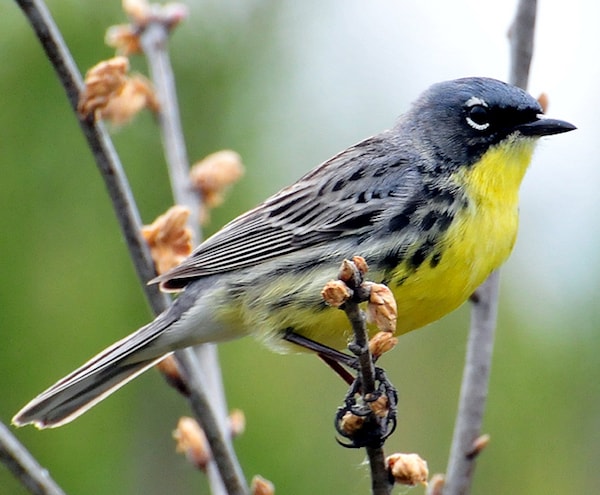
Some warblers do a bit of a tail flare to expose white or colorful tail patterns, presumably to startle insects into movement so the warbler can dine on them. The magnolia warbler has a white stripe across the tail that it flares often, which helps identify it.
The hooded warbler flicks its tail to reveal copious white there, and the American redstart flares its orange- or yellow-and-black tail, with a pattern that is distinctive in itself. The redstart is also an adept flycatcher, sallying out into the air for a meal. It’s something many warblers may do, but the redstart is particularly prone to foraging like this.
Tip #4: Consider the Voice
As warblers move northward toward the breeding grounds, the hormones start to pump through their systems, and in turn the males start trying out their songs. Voice is a fantastic way to find and identify warblers, but it does take some focus and practice.
If you are a newbie to voice identification, my advice is not to play the CD over and over such that you become so confused and frustrated that you start to think about throwing in the towel. Instead, concentrate first on the buzzy or distinctive warbler songs. Listen to the CD and find the buzzy black-throated green and black-throated blue warblers.
These have distinctive patterns: a zoo-zee-zoo-zoo-zwee and a zur-zree-zreee-ZRRREEE (or “I am la-zy”), respectively. Similarly, the two- to three-note odd buzzes of the blue-winged and golden-winged warblers are simple to learn, as is the rising buzz of a trill of the northern parula, which climbs in pitch and seems to spill over the top at the end. Add to this the wichity-wichity-wichity of the common yellowthroat, and you are on your way.
Start with a few distinctive songs, and then use these as reference points to learn more. Also, go out with a friend who has done the heavy lifting already, and ask for tips that work for him or her.

You have noticed by now that I have talked little about color. The field guides and many of the identification aids out there concentrate so much on the color of warblers that all the other characteristics—behavior, habitat, song, and shape—get little mention. You will, naturally, rely greatly on color to identify warblers, but watch for all these other indicators too.
Before you know it, you’ll be able to identify that dull bird way up in the tip-top of a tree that some are trying to make into a yellow-rumped warbler as a Cape May—partly just by where it is, and partly because of the “feel” the bird gives you. Or you may be walking through the woods, see a silhouette of a slim, tail-wagging bird not too high up in the shrubbery, and you’ll think “probably a palm warbler.” You will be well on your way to mastering those golden gems we call warblers.
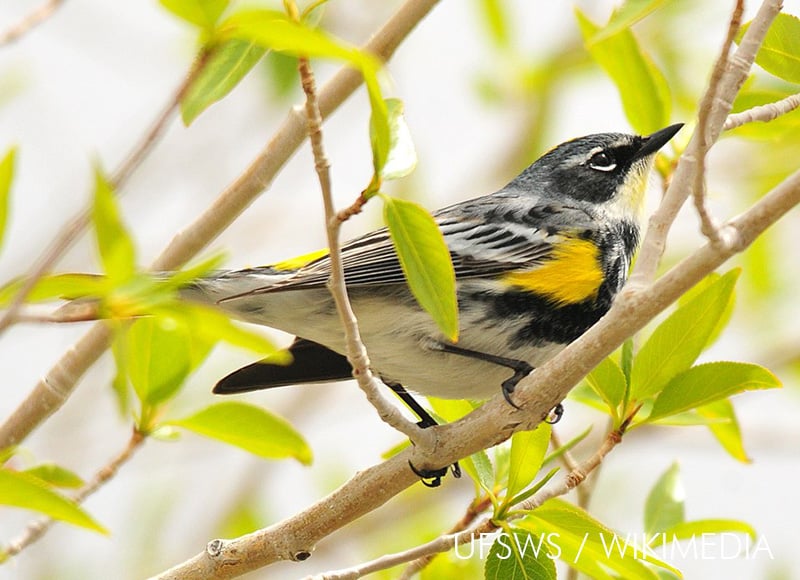
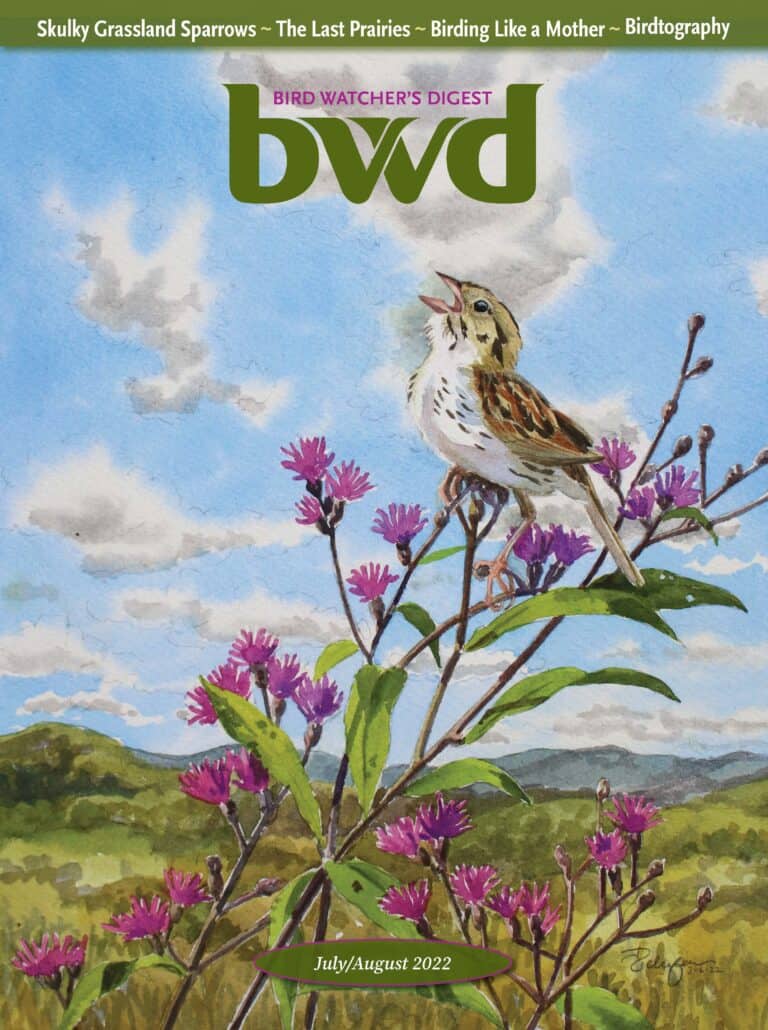
Looking to Subscribe?
Get 6 print issues of the magazine delivered to your door & free digital access
One Year Print Subscription: $26
(to US or Canada, includes digital access)
One Year Digital-only Subscription: $15

